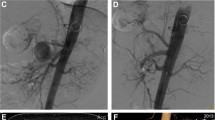Abstract
The purpose of this study was to evaluate clinical results and technical problems of transcatheter coil embolization for splenic artery aneurysm. Subjects were 16 patients (8 men, 8 women; age range, 40-80 years) who underwent transcatheter embolization for splenic artery aneurysm (14 true aneurysms, 2 false aneurysms) at one of our hospitals during the period January 1997 through July 2005. Two aneurysms (12.5%) were diagnosed at the time of rupture. Multiple splenic aneurysms were found in seven patients. Aneurysms were classified by site as proximal (or strictly ostial) (n = 3), middle (n = 3), or hilar (n = 10). The indication for transcatheter arterial embolization was a false or true aneurysm 20 mm in diameter. Embolic materials were fibered coils and interlocking detachable coils. Embolization was performed by the isolation technique, the packing technique, or both. Technically, all aneurysms were devascularized without severe complications. Embolized aneurysms were 6–40 mm in diameter (mean, 25 mm). Overall, the primary technical success rate was 88% (14 of 16 patients). In the remaining 2 patients (12.5%), partial recanalization occurred, and re-embolization was performed. The secondary technical success rate was 100%. Seven (44%) of the 16 study patients suffered partial splenic infarction. Intrasplenic branching originating from the aneurysm was observed in five patients. We conclude that transcatheter coil embolization should be the initial treatment of choice for splenic artery aneurysm.






Similar content being viewed by others
References
Stanley JC, Thompson NW, Fry WJ, et al. (1970) Splanchnic artery aneurysms. Arch Surg 101:689
Dave SP, Reis ED, et al. (2000) Splenic artery aneurysm in the 1990s. Ann Vasc Surg 14:223–9
Saro JA, Salmenkivi K, Tenhunen A, et al. (1986) Rupture of splanchnic artery aneurysms. World J Surg 10:123
Stanley JC, Fry WJ, et al. (1974) Pathogenesis and clinical significance of splenic artery aneurysms. Surgery 76:898
Stanley JC, Zelenock GB, et al. (1995) Splanchnic artery aneurysms. In Rutherford RB (ed) Vascular surgery, 4th ed. W. B. Saunders, Philadelphia, p 1124
Trastek VF, Pairolero PC, Joyce JW, et al (1982) Splenic artery aneurysms. Surgery 91:694
Pomerantz RA, Eckhauser FE, Strodel WE, et al. (1986) Splenic aneurysm rupture in cirrhotic patients [Letter]. Arch Surg 121:1095
Trastek VF, Pairolero PC, Bernatz PE, et al. (1985) Splenic artery aneurysms. World J Surg 9:378–383
McDermott VG, Shlansky-Goldberg R, et al. (1994) Endovascular management of splenic artery aneurysms and pseudo-aneurysms. CardioVasc Interv Radiol 17:179–184
Guillon R, Garcier JM, et al. (2003) Management of splenic artery aneurysms and false aneurysms with endovascular treatment in 12 patients. CardioVasc Interv Radiol 26:256–260
Larson RA, Solomon J, et al. (2002) Stent graft repair of visceral artery aneurysms. J Vasc Surg 36:1260–1263
Yoon H-K, Lindh M, et al. (2001) Stent-graft repair of a splenic artery aneusysm. CardioVasc Interv Radiol 24:221–224
Jonasson O, Spigos DG, et al. (1985) Partial splenic embolization. Experience in 136 patients. World J Surg 9:461–467
Yamada N, Hayashi K, Murao K, et al. (2004) Time-of-flight MR angiography targeted to coiled intracranial aneurysms is more sensitive to residual flow than is digital subtraction angiography. Am J Neuroradiol 25:1154–1157
Lagana D, Carrafiello G, Mangini M, et al. (2006) Multimodal approach to endovascular treatment of visceral artery aneurysms and pseudoaneurysms. Eur J Radiol 59:104–111
Author information
Authors and Affiliations
Corresponding author
Rights and permissions
About this article
Cite this article
Yamamoto, S., Hirota, S., Maeda, H. et al. Transcatheter Coil Embolization of Splenic Artery Aneurysm. Cardiovasc Intervent Radiol 31, 527–534 (2008). https://doi.org/10.1007/s00270-007-9237-9
Received:
Revised:
Accepted:
Published:
Issue Date:
DOI: https://doi.org/10.1007/s00270-007-9237-9




